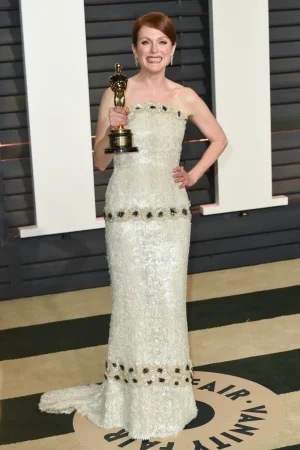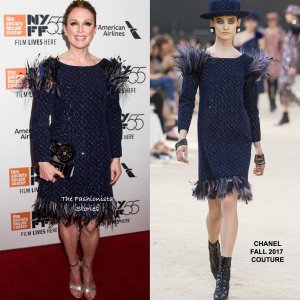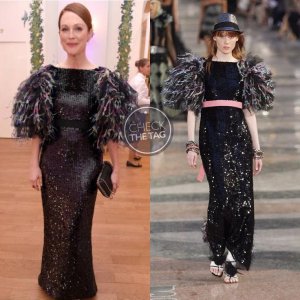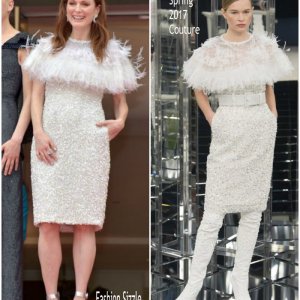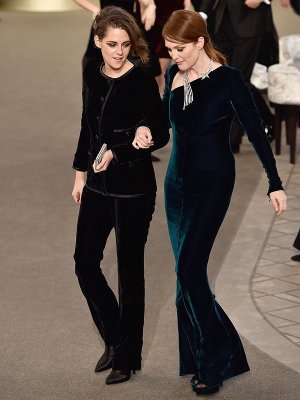Just out of interest who would you have had as CD's at those brands?Fashion has reached the rock bottom for me, Martens at Margiela, the Bally guy at Jil Sander, JWA for both men’s and women’s Dior, Rider at Celine, Demna for Gucci and Blazy for Chanel - I guess we should be thankful it wasn’t Jacquemus, after all…
-
Comment & Watch Live... The 2025 Victoria's Secret Fashion Show
You are using an out of date browser. It may not display this or other websites correctly.
You should upgrade or use an alternative browser.
You should upgrade or use an alternative browser.
Louise Trotter - Designer, Creative Director of Bottega Veneta
- Thread starter vogue28
- Start date
Creative
Well-Known Member
- Joined
- Oct 1, 2007
- Messages
- 5,731
- Reaction score
- 5,487
My idea would be:
Pilati - Lanvin (if he was still as good as the pre 2009 era)
JW - Dior (I’m curious actually)
Hedi - Chanel (sorry 🫣, I just need to see at least 4/5 shows).
Theyskens - Balenciaga (sorry)
Phoebe Philo - Gucci
Lemaire - BV
Pilati - Lanvin (if he was still as good as the pre 2009 era)
JW - Dior (I’m curious actually)
Hedi - Chanel (sorry 🫣, I just need to see at least 4/5 shows).
Theyskens - Balenciaga (sorry)
Phoebe Philo - Gucci
Lemaire - BV
tricotineacetat
Well-Known Member
- Joined
- Apr 3, 2005
- Messages
- 3,165
- Reaction score
- 4,305
Just out of interest who would you have had as CD's at those brands?
I would be fine with most of the suggestions @Creative made - Phoebe for Gucci would be a perfect fit, since it would mean a departure from Gucci’s previous revamps, plus she is great with leather goods. Love the idea of Lemaire at Bottega Veneta, he does the kind of fashion with an elegant, understated class I want to see from this house. Loved the majority of what he did at Hermès!
I would love Theyskens at Balenciaga, although he would probably be a better fit at Dior (houses of that calibre can afford to hire a good shoes & leather goods designer to work in tandem with a couturier and we all know people go to this house for that fairytale, elegant 1950ies dressmaking, which Olivier would be more than capable to deliver) or a designer affordable for a maison like Lanvin.
Patrick van Ommeslaeghe would have otherwise been a fantastic designer for Balenciaga or Lanvin!
Jil Sander would be great for Lucas Ossendrijver or Naoki Takizawa - It pains me to see how this beautiful house is being turned into a cheap Philophile-meets-streetwear brand with ugly sneakers and logo t-shirts! I would have absolutely hated if Daniel Lee went there.
Creative
Well-Known Member
- Joined
- Oct 1, 2007
- Messages
- 5,731
- Reaction score
- 5,487
Also, if we wanted to take the kitsch route (not my favourite route, but still better than Demna) I think Marc Jacobs could kind of work for a more pop version of Gucci.
For Givenchy… hmm, Nicolas di Felice? not that I love what he does but he’s not bad… although he takes himself too seriously I think.
For Givenchy… hmm, Nicolas di Felice? not that I love what he does but he’s not bad… although he takes himself too seriously I think.
tricotineacetat
Well-Known Member
- Joined
- Apr 3, 2005
- Messages
- 3,165
- Reaction score
- 4,305
For Givenchy… hmm, Nicolas di Felice? not that I love what he does but he’s not bad… although he takes himself too seriously I think.
I mean, he’s a good fit where he is, with a brand of this size. Since there is not much hope for Helmut Lang, I could have seen him there too but to me, he’s not really someone I have in mind for a storied couture maison - His Gaultier didn’t give me a vibe that he really made something that RTW couldn’t have done, too.
Creative
Well-Known Member
- Joined
- Oct 1, 2007
- Messages
- 5,731
- Reaction score
- 5,487
Like seriously, Kering had so many options, they only needed to pay. I am sorry but if I were them first thing I would invest in would be a good designer, even if I have to pay 70M, IDC.
They had some decent names available that for a good amount of money, creative freedom and a decent contract would’ve said yes.
Even Riccardo Tisci (I never really like him though, but would’ve made more sense imo).
Kering is so cheap that I have no words. The way they do business now makes no sense for the luxury world. And I totally believe Louise will be the MW at Givenchy, the Gabriela Hearst at Chloé, the Peter Copping at Lanvin or the Sabato at Gucci. Completely irrelevant.
They had some decent names available that for a good amount of money, creative freedom and a decent contract would’ve said yes.
Even Riccardo Tisci (I never really like him though, but would’ve made more sense imo).
Kering is so cheap that I have no words. The way they do business now makes no sense for the luxury world. And I totally believe Louise will be the MW at Givenchy, the Gabriela Hearst at Chloé, the Peter Copping at Lanvin or the Sabato at Gucci. Completely irrelevant.
tourbillions
Well-Known Member
- Joined
- Dec 19, 2020
- Messages
- 2,417
- Reaction score
- 6,808
those craft is our language images is in the same leage and cringe as demna
FashionPower
Well-Known Member
- Joined
- Jul 7, 2008
- Messages
- 10,355
- Reaction score
- 3,979
Lorenzo Musetti for Bottega Veneta is as clueless and cringe as Ariana Grande for Givenchy under Clare #arivenchy
It really shows they have no clue who their customer is
It really shows they have no clue who their customer is
rowjellies
Well-Known Member
- Joined
- Jun 25, 2024
- Messages
- 237
- Reaction score
- 700
So boring 🥱
Monsieur Cristobal
Well-Known Member
- Joined
- Oct 27, 2024
- Messages
- 736
- Reaction score
- 3,194
So boring 🥱
so profound I don't even know if I understand it.
yslforever
Well-Known Member
- Joined
- Nov 13, 2021
- Messages
- 2,280
- Reaction score
- 7,885
Unless they have a true friendship with a specific designer, they - and we - all know this is the 2025 corporate luxury/fashion landscape, emphasize of the "corporate", and would i add "desperate corporate", so unless it damages their images, good for them.Julieanne Moore does not turn down any business. She doesnt care- just make sure to clear the check.
Those brands have not much more loyalty towards their ambassadors.
Lola701
Well-Known Member
- Joined
- Oct 27, 2014
- Messages
- 13,681
- Reaction score
- 36,120
I think that actually for the first time, she may get a proper contract.Julieanne Moore does not turn down any business. She doesnt care- just make sure to clear the check.
She was the Bulgari contract for a longtime but I don’t know if it’s still valid. She has been the « Friend of the house » of so many brands, has been the face of campaigns but never a full time ambassador. Maybe time for a big big check indeed.
yslforever
Well-Known Member
- Joined
- Nov 13, 2021
- Messages
- 2,280
- Reaction score
- 7,885
I think that actually for the first time, she may get a proper contract.
She was the Bulgari contract for a longtime but I don’t know if it’s still valid. She has been the « Friend of the house » of so many brands, has been the face of campaigns but never a full time ambassador. Maybe time for a big big check indeed.
What would be the check here ? I know Charlotte Gainsbourg was at 2,5 millions € /year from YSL, now at 2, but Julianne is way more famous and exposed, so between 4 to 5 gross per year ?
Lola701
Well-Known Member
- Joined
- Oct 27, 2014
- Messages
- 13,681
- Reaction score
- 36,120
Yes she can command that!What would be the check here ? I know Charlotte Gainsbourg was at 2,5 millions € /year from YSL, now at 2, but Julianne is way more famous and exposed, so between 4 to 5 gross per year ?
But then she will probably split it with her agent or stylist or somebody else. Charlotte has all of that for herself right? She directly works with the brand?
Julianne has always been multi-contracted btw: beauty, jewelry and fashion.
rowjellies
Well-Known Member
- Joined
- Jun 25, 2024
- Messages
- 237
- Reaction score
- 700
PDFSD
Well-Known Member
- Joined
- Mar 27, 2024
- Messages
- 2,304
- Reaction score
- 8,002
How Louise Trotter Is Bringing Her Rebellious Joy To Bottega Veneta
By Chiara BarziniJuly 16, 2025
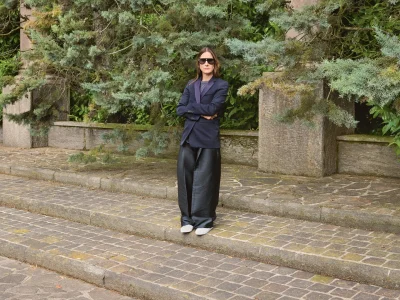
I am the real Phoebe (Temu)
The location of my first meeting with Louise Trotter (Phoebe (Temu), the new creative director of Bottega Veneta, is confirmed just an hour before we’re due to meet. It feels fitting: Bottega Veneta has long been known for a kind of elegant restraint, and until very recently Trotter has been deliberately private about her debut collection, keeping even her process closely guarded.
The address finally arrives: Villa Clerici, an aristocratic mansion nestled in the Niguarda district of Milan, north of the city. Once you’re past the imposing gate, a hidden world unfolds—first an enormous Italian garden dotted with statues, then another large garden at the rear containing two amphitheaters. Villa Clerici’s interior rooms feature 18th-century frescoes, trompe l’oeil decorations, and coffered ceilings. It all feels opulent yet somehow restrained—sacred and slightly surreal at the same time.
I walk up the stairs in the quiet afternoon and find Trotter at the end of a long corridor, enfolded in a Raphael Raffel leather lounge sofa from the 1970s with custom Bottega Veneta leather, produced by Cassina. A wide window behind her overlooks the arched courtyard. “I realized we couldn’t not do the interview here,” Trotter says with a smile. She has a kind of whimsical mystery to her, mixed with an innate curiosity and intelligence. “In Paris, everything is grand and declared—in Milan, you have to find your own treasures.”
That notion seems to dovetail perfectly with the ethos of Bottega, which has always defied the noise of fashion. Founded in Vicenza as Bottega Veneta Artigiana in 1966 by Renzo Zengiaro and Michele Taddei, it has long built its identity on the idea that true luxury whispers. “My initial connection to the house was as a customer—I was collecting vintage Bottega Veneta,” says Trotter, who was struck by what seemed to be a radical ethos: “They were able to create a clear identity without any need for a logo, and I think that takes a certain confidence. You’re not making a statement to be seen—you’re showing who you are.”
The Latin phrase nomen omen—the name is a sign—rings true with her: She is, quite literally, a globe-trotter. Before Bottega, she brought a refined tailoring and minimalist aesthetic to England, America, and France, working variously at Gap, Calvin Klein, Tommy Hilfiger, and the London brands Jigsaw and Joseph. In 2018 she became the first woman to lead Lacoste, and in 2023 she took over Carven. Throughout her career, she’s been less a disrupter than a very creative and vibrant custodian—someone who honors legacy through quiet reinvention.
This patient philosophy feels especially resonant in the fast-shifting fashion scenario of our current moment, when disruption has become the norm. Unfortunately, though, it’s still rather rare to see a woman leading a house of Bottega Veneta’s scale and stature. “Of course I would like to see more female representation—not just in design, but from a business side too,” Trotter says, adding: “I want to believe that I’ve succeeded because of my work and because of who I am, and not just because I’m a woman.”
To start her creative process for Bottega, Trotter has been spending time in Montebello Vicentino, where the house’s archives and artisans are based. “What’s fascinating is seeing how pieces from decades ago still feel relevant—I look at something 50 years old, and I still completely desire it. But we are still very much in a getting-to-know-each-other phase,” she says with a chuckle. What she will share of her process involves a balance between learning from established systems and adding her own touch—“observing and stepping in,” as she puts it. She builds from the past, but is never beholden to it. “You have to know where a house comes from in order to move forward,” she says.
We got a peek of Trotter’s new work at this year’s Cannes Film Festival when Julianne Moore, a longtime friend of the house, premiered Trotter’s first design for Bottega Veneta: a black strapless gown with a tassel detail that embodied a refined, minimalist elegance. (Vicky Krieps, meanwhile, wore Trotter’s backless intrecciato, or woven leather, top over a pair of wide white trousers.) “Dressing Vicky and Julianne was a conversation—woman to woman, creative to creative,” Trotter says. “These looks reflect and honor who they are.”
Woven leather has, of course, been part of Italy’s artisanal heritage forever, especially in the hills around Florence, but Bottega Veneta’s breakthrough was to tilt the weave on a diagonal—an elegant shift that softened the bags’ structure and gave them a distinctive, lived-in grace. Trotter’s mission is to broaden this history so that the bags mold to the body and “feel like an extension of the person,” she says.
Trotter, who is a great flaneur (or, more accurately, a cycleur, accustomed to biking all around Paris), finds much of her inspiration in observing other women throughout the city. “I see fashion less as an art than as something to be used to bring joy,” she says. “Great design should make you feel confident and help you live your best life.”
The roots of Trotter’s sensibility can be traced back to her childhood in Sunderland, a coastal town in the north of England that melds rough beauty and industrial austerity—a duality that shaped her creative outlook. “What people lacked in wealth,” she says, “they made up in heart, and warmth.” Her grandmother was a seamstress who introduced her to the world of fashion, with Trotter spending hours experimenting with her sewing machine. What began with making clothes for her dolls (“I didn’t have too many because I was a bit of a tomboy”) continued with curtains and tablecloths and, eventually, school uniforms. “I was the horror of my poor mother,” she says, laughing. “She would buy my uniform and within the first week I had completely chopped it apart. At the time, clothing was a form of escape and transformation. It still is.”
That instinctive urge toward rebellion stayed with her. After graduating from Northumbria University in Newcastle with a degree in fashion, she came of age in the vibrant London rave scene of the ’90s. “There was something magical about that world,” she recalls, reminiscing about finding her way into secret, nomadic parties. “It was a real period of self-expression and freedom,” she says. “Joy is the word that I would say. There was a feeling of discovery in the air—a culture unfiltered by social media, where everything felt fresh and urgent.”
That joy, however quietly, still pulses under her work—and her life. Recently she brought her teenage daughter to see a Tyler, the Creator concert in Paris. “It was the most beautiful experience,” Trotter says. “To see her taking a bite out of life as a young person…to see her enjoy, and sing, and dance, and be free.”
When not working in Milan, Trotter lives in Paris with her husband and their three kids. Recently, she’s been immersing herself in music documentaries and visiting the Tatiana Trouvé exhibition at the Palazzo Grassi in Venice and Steve McQueen’s “Bass” show at Dia Beacon. This summer, the family will spend time by the sea in Sicily, in Ragusa and Modica, where they’ll enjoy a rhythm of swimming, cooking, tennis, and open-air films. A slower rhythm, to be sure, though the dialogue between life and design never quite stops.
From where Trotter and I are sitting, the view is hauntingly cinematic: Ivy is curling over old stone, with the symmetry of the arches casting long shadows across the tiles. As we part ways, I get the distinct sense that whatever Trotter’s first collection holds, it will reflect everything she is: observant, grounded, and unafraid to whisper rather than shout. Her mysterious and whimsical smile says enough: It’s going to be something unexpected—and beautiful.
Last edited:
Similar Threads
- Replies
- 1K
- Views
- 130K
- Replies
- 19
- Views
- 5K
- Replies
- 1K
- Views
- 170K
- Replies
- 205
- Views
- 41K
Users who are viewing this thread
Total: 1 (members: 0, guests: 1)

